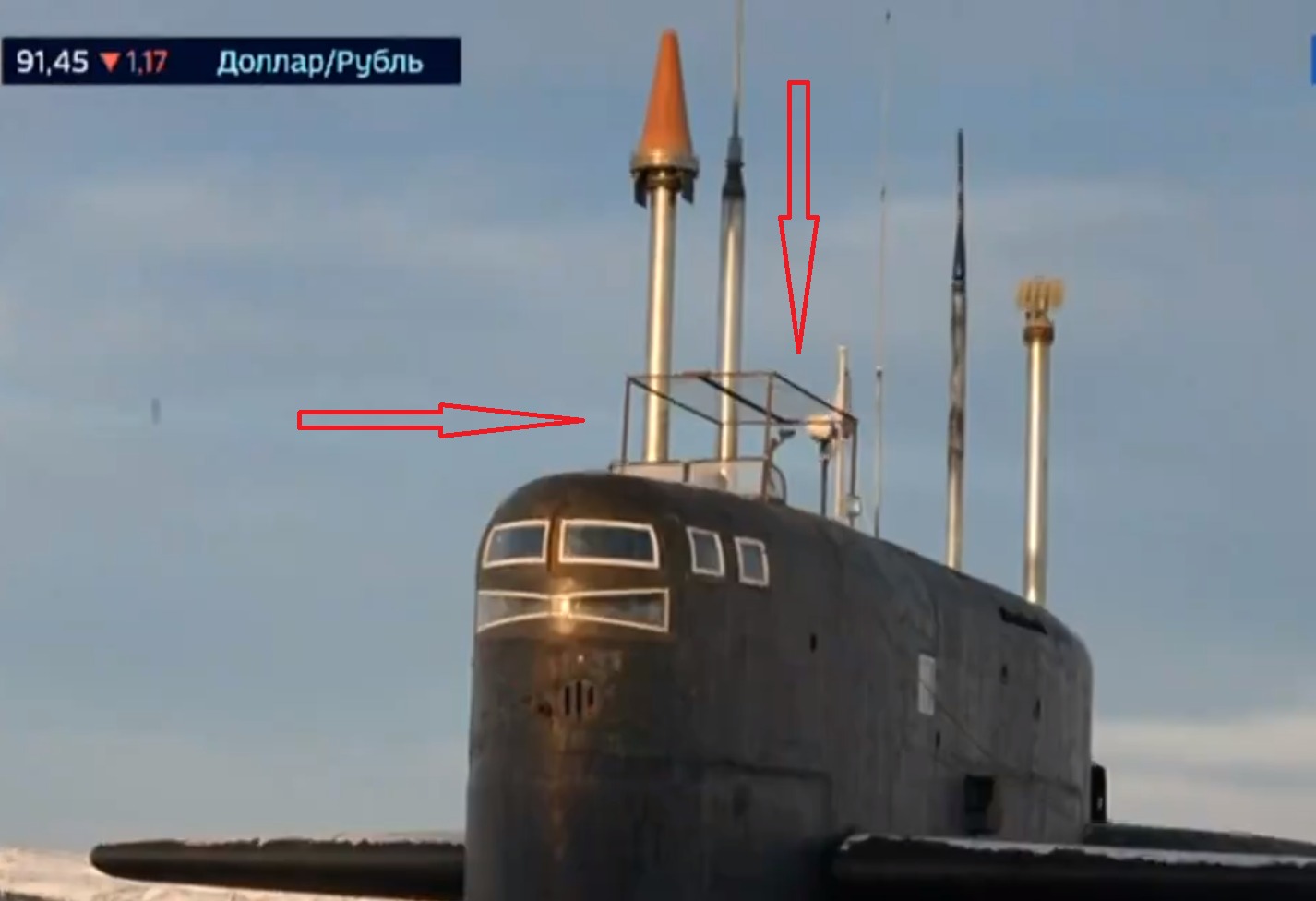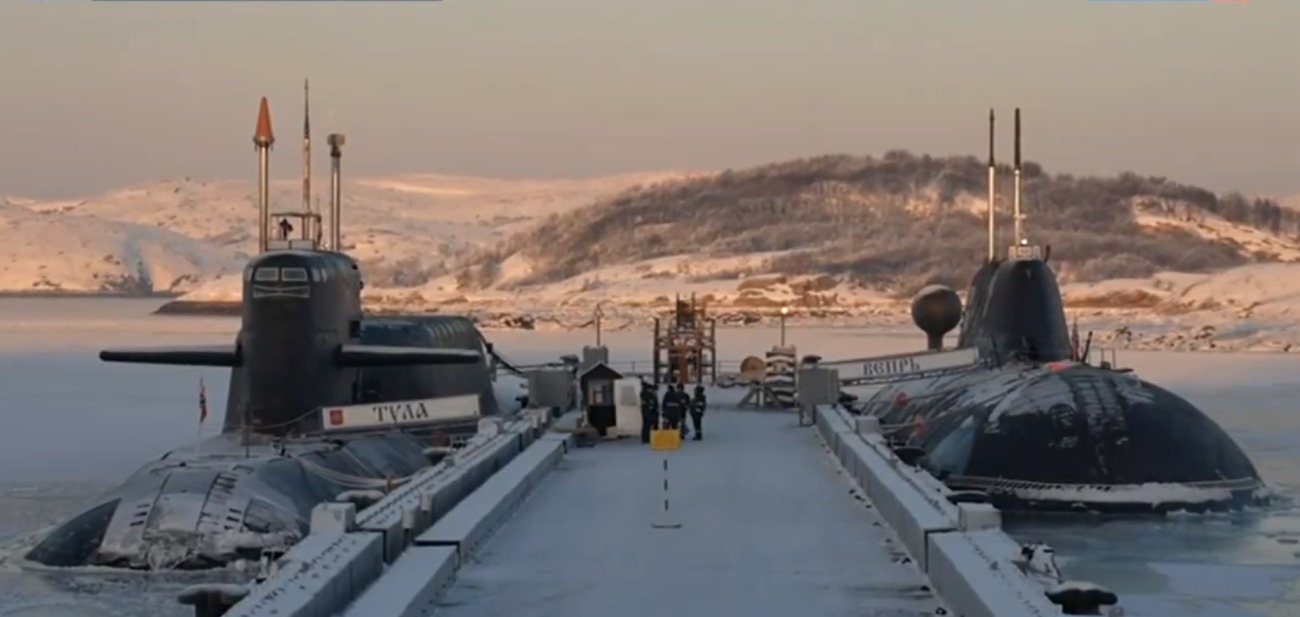After losing about a third of its Black Sea Fleet (BSF) vessels, Russia is expanding efforts to protect the rest of its fleet from potential Ukrainian attacks.
Russia’s Delta-IV class nuclear ballistic missile submarine Tula now appears to have an armor screen, aka cope cage, on top of its conning tower. Reports speculate that this move may be intended to protect the vessel against a potential drone attack.
The suspected drone countermeasure was first observed on Tula during a recent broadcast on Russia-24, the state-run television channel. The submarine, homeported in Gadzhiyevo in the far northern Murmansk region of Russia, is part of the Russian Navy’s Northern Fleet and is referred to as a Project 667BDRM or Delfin class boat.
Cope cages, also called slat armor, bar armor, cage armor, or stand-off armor, are a unique defense employed on heavy military vehicles to reduce damage by high-explosive anti-tank (HEAT) weaponry.
They were first sighted atop Russian T-80 tanks in late 2021. Russia has expanded the use of its tanks, artillery, and ground vehicles to protect against Ukrainian drone attacks, which have seen an unprecedented hike in the last year.

However, this seems to be the first time that add-on protection of this type, which is now mounted on tanks and other armored vehicles on both sides of the conflict in Ukraine, has been placed on a naval vessel of any kind. This demonstrates the increasing prevalence of drone threats, which threaten the Russian forces at sea as much as it does on the ground.
SSBN K-114 Tula project 667BDRM – DELTA-IV
SSN K-157 Vepr Project 971 Akula II
🗺️Gadzhievo (Murmansk region)
📹"Vesti" (March 2024) pic.twitter.com/u8HGOXvd6H— Massimo Frantarelli (@MrFrantarelli) March 19, 2024
Vice Admiral Shekhar Sinha, Indian Navy (retired), was discerning in his observation when he said, “It is a protective mechanism to prevent bombs dropped by drones in the harbor.”
Even though Russia has yet to officially acknowledge the development, veterans and military experts unanimously agree that the structure has been set atop the submarine to protect against munitions dropped from drones.
Commodore Anil Jai Singh, a veteran submariner from the Indian Navy, told the EurAsian Times, “Apparently, these are protection for the bridge crew against drone attacks. They are used on tanks, etc., but for the first time, they are seen on submarines. Submarines anyway spend minimum time on the surface unless they are in the harbor.”
Some military watchers noted that the structure could have been installed to serve as a sun cover or perform another function, specifically since the submarine is not part of the Crimea-based BSF that has repeatedly been attacked by Ukraine.
However, Commander Ashok Bijalwan, another veteran Indian Navy submariner, conjectured, “It appears to be some sort of a protective cover during surface navigation. I doubt if the submarine will be able to dive with this structure kept there.”
Gadzhiyevo is over a thousand miles from both the Ukrainian battle lines and seemingly beyond the country’s long-range kamikaze drones. Further, there is no indication that the submarine equipped with armor screens would be transferred to the Russian Black Sea fleet and deployed at the frontline against Ukraine.
However, Russian troops use the region to launch air strikes on Ukrainian cities, and some experts have predicted that Murmansk may be on Ukraine’s radar. While Ukrainian forces have demonstrated their ability to launch attacks deep inside Russian territory even by that measure, Murmansk seems to be too far for Kyiv to reach.
In any event, the screen’s design resembles the add-on counter-drone top armor that Russian troops started equipping their tanks with within days, leading to their full-scale invasion of Ukraine. Several distinct vehicle types have been observed to sport a diverse range of armor screen designs.
Nevertheless, it may be catastrophic if a drone strike on a submarine is successful. Devastating fires might be started by a drone, even one with a small warhead. Russia may be wary since it already had a submarine, Rostov-on-Don, which, according to Ukraine, was damaged beyond repair in a night-time missile attack.
Even if these cope cages were installed on the Russian submarine to protect against drone attacks, they are not fool-proof solutions. There have been several instances of Russian tanks with cope cages struck and damaged by Ukrainian drones and FPVs.
So, the Russian forces have devised another method to protect their submarines and vessels of the vulnerable Black Sea Fleet: decoys.

Russia Is Fooling Ukrainian Drones
A UK intelligence report published recently claims that Russia is trying to fool Ukraine, which is destroying its warships, by painting silhouettes of naval vessels on land.
The UK Ministry of Defence stated that “silhouettes of vessels have also been painted on the side of quays, probably to confuse uncrewed aerial vehicle operators.”
It also published satellite images that purportedly depicted a painted submarine silhouette on a wharf next to a real submarine. This was allegedly spotted at the Black Sea port of Novorossiysk, Russia, which has been attacked by Ukraine multiple times.
“It is unlikely that the use of maskirovka [camouflage and deception – ed.] techniques will lead to any significant reduction in losses,” the assessment noted.
This development comes as Ukraine has deployed a menacing and powerful weapon: unmanned boats. These boats launch high-stakes attacks against large and sophisticated Russian vessels. Sea drones have emerged as one of the significant weapons deployed by the Ukrainian military, which does not have a regular navy, unlike the Russians.
Latest Defence Intelligence update on the situation in Ukraine – 20 March 2024.
Find out more about Defence Intelligence's use of language: https://t.co/aCbSXPVpTt #StandWithUkraine 🇺🇦 pic.twitter.com/DmWPWyqVUk
— Ministry of Defence 🇬🇧 (@DefenceHQ) March 20, 2024
Amidst increasing unmanned surface vessel (USV) attacks on the Black Sea Fleet (BSF), Russian Defense Minister Sergei Shoigu visited the BSF headquarters in Crimea on March 17. According to reports, Shoigu ordered additional measures for the BSF to minimize the threat posed by unmanned aerial vehicles and unmanned surface vehicles.
Ukraine packs these vessels with explosives and deploys them against Russia. These drone boats dart over the water’s surface and leave no trace of their presence, thanks to their low radar signature. They are also equipped with advanced GPS and video systems. Since Russian warships have endured attacks from these small yet powerful drone boats, it wants to avert a similar fate for its submarines.
The submarines docked at the port are also vulnerable to attack by aerial unmanned vehicles or loitering munitions dispatched by Ukraine. Thus, the deception tactic may have been considered as a sound strategy.
The UK intelligence assessment also claimed that the Black Sea Fleet’s ships have black paint on their bow and stern, which is intended to make them appear smaller and less vulnerable to attack.
- Contact the author at sakshi.tiwari9555 (at) gmail.com
- Follow EurAsian Times on Google News




